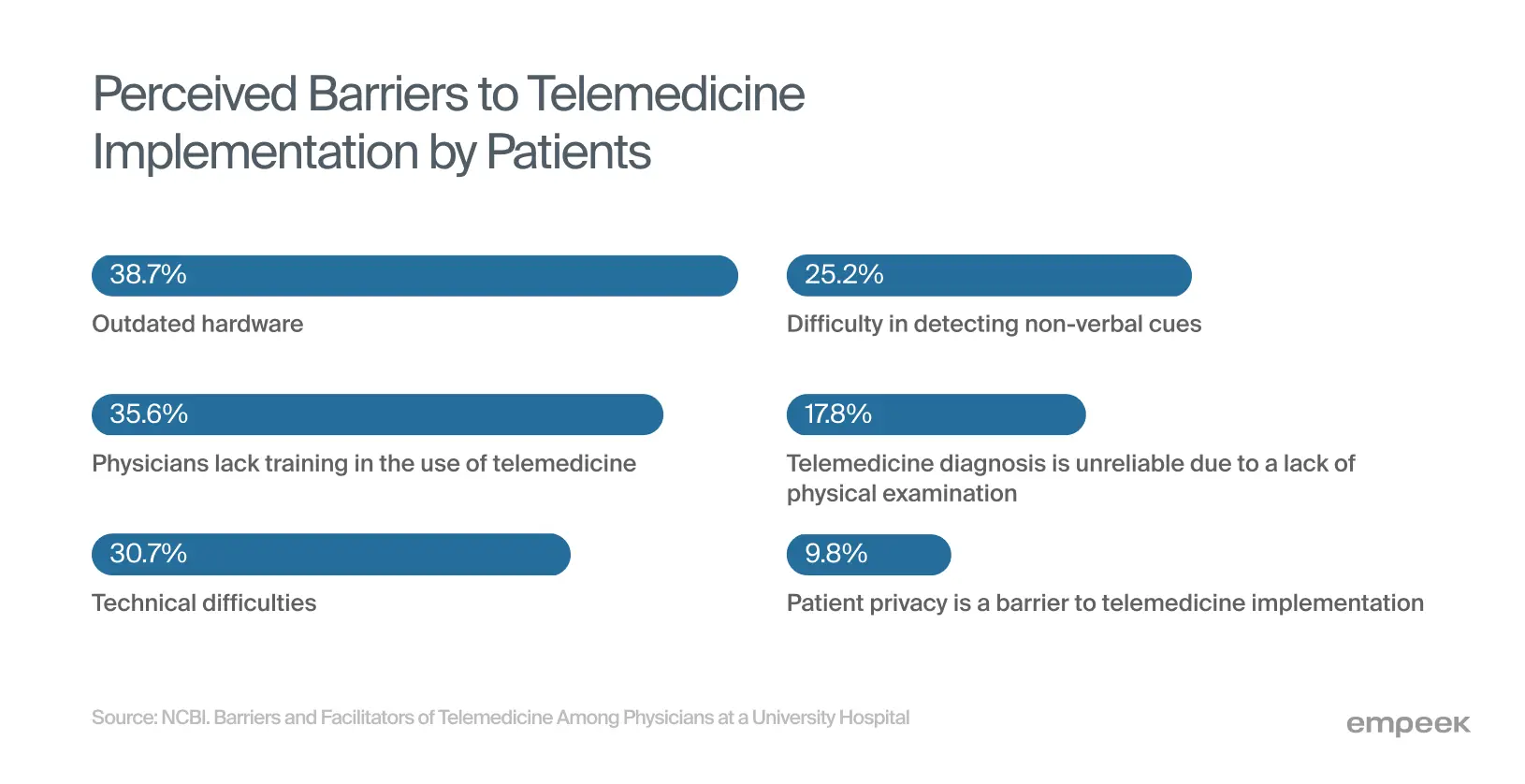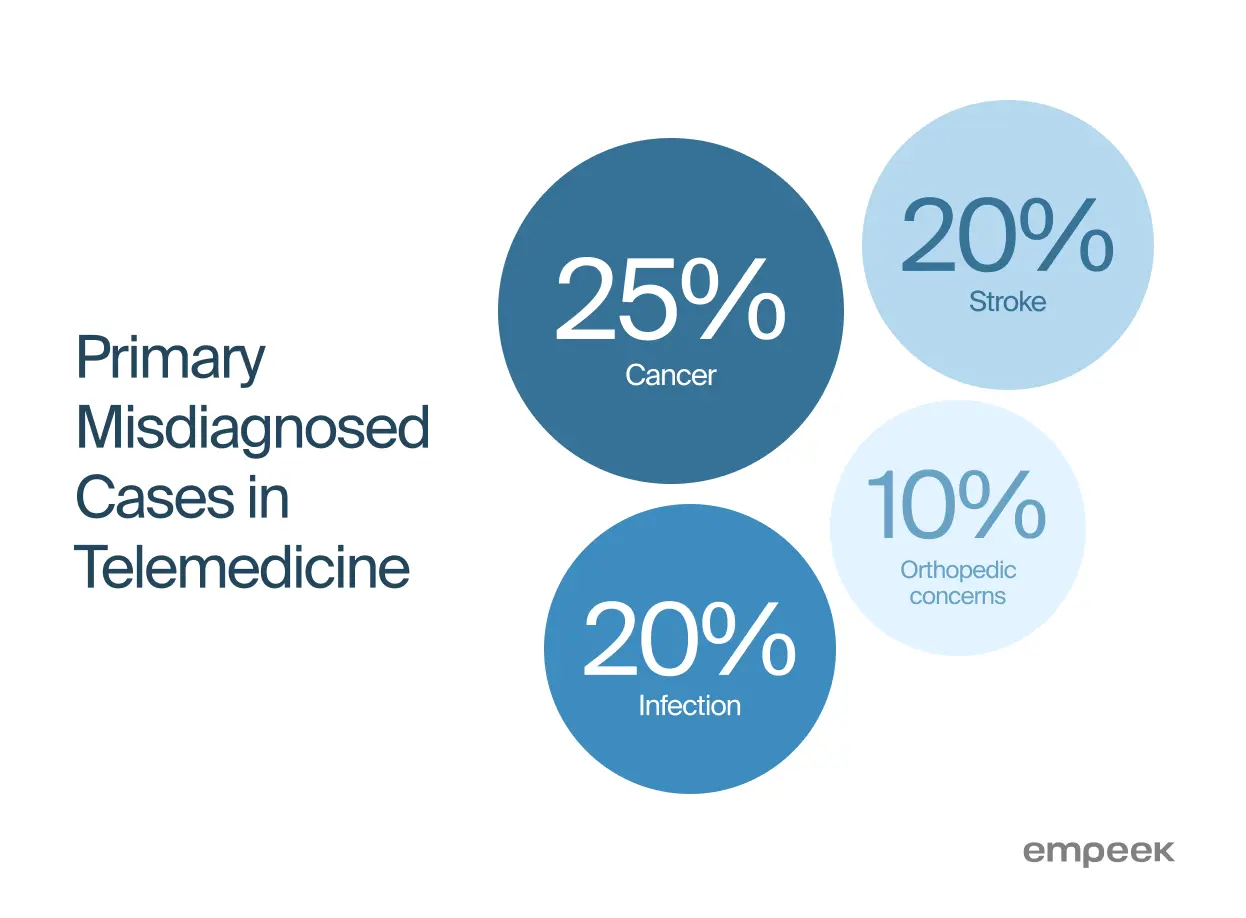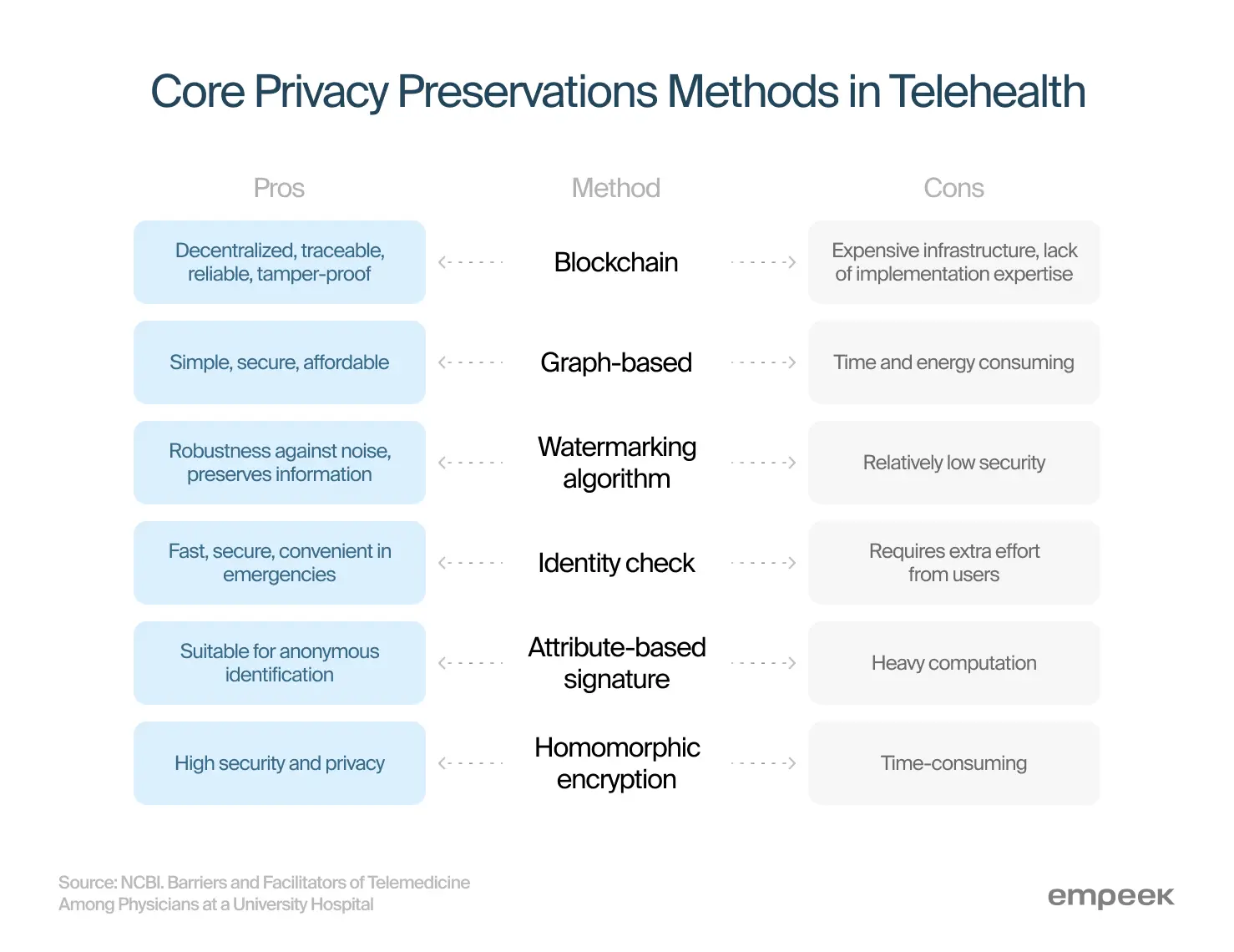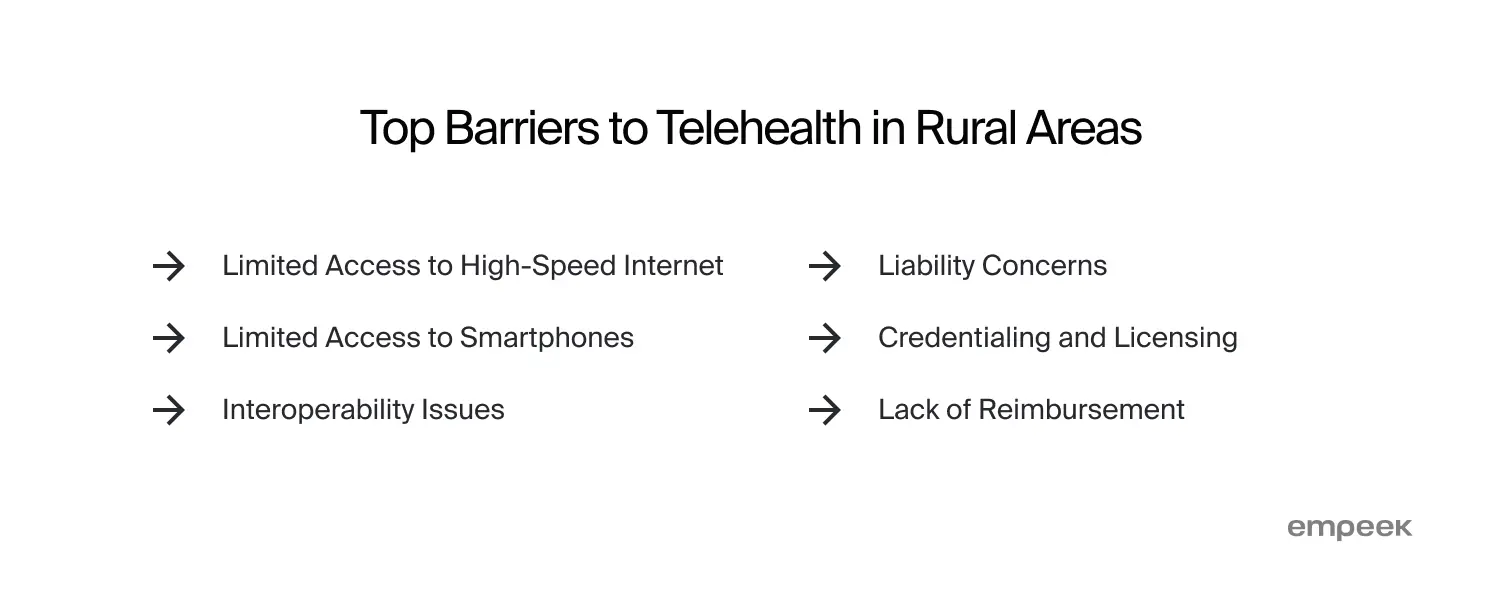Telemedicine achieved an 80% adoption rate and became a go-to method for minor disease treatment, chronic disease management, and prescription care. Yet, several barriers prevent people from using telehealth more frequently, such as data security, fear of diagnostic errors, digital literacy, and limited access in rural areas, among others.
Both patients and providers face equally strong telehealth challenges while implementing and using the system. Fortunately, high adoption rates also mean there are multiple effective ways to overcome the barriers and adapt to them. You just need to know the pitfalls from the start and adopt the right telehealth implementation strategy.
More about telehealth benefits and barriers and ways to handle them in our post.
Barriers to Telemedicine for Patients
From concerns about care quality to worries about data security, various factors can influence patients’ experiences. The most frequent barrier that makes people doubt the efficiency of telehealth adoption is the belief that physicians lack training to provide proper care online. Another common barrier is the perception that diagnoses made with telemedicine solutions are less reliable due to limited physical examination. Patients think that face-to-face examinations are more accurate than online check-ups. They also often mention the complicated identification of non-verbal cues through virtual consultations as a barrier to the effective use of telemedicine platforms.
Here are the insights from the recent research on patients’ telehealth opinions.

Despite the diversity of telehealth challenges that patients face or fear to face using telemedicine solutions, the most common are diagnostic errors, data breaches, and low digital literacy of patients in rural areas. They considerably affect the telehealth industry and discourage many patients from shifting to telemedicine care.
Misdiagnosis or Diagnostic Errors
In contrast to an in-person clinical visit, telemedicine appointments make physicians depend on a patient’s verbal description and interpretation of their symptoms to make a diagnosis. Without the advantage of testing and hands-on physical examination, the risk of misdiagnosis, overlooking symptoms or physical cues, and prescribing inappropriate treatment is higher. It is also important to note that prescribing medication across state lines without conducting an in-person examination can be considered a criminal offense in some states.
According to The Doctors Company, a prominent malpractice carrier, diagnostic errors are the most frequent allegations in telemedicine-related claims. The main misdiagnosed through telemedicine cases are related to the following:

To reduce the risk of misdiagnosis or diagnostic errors, healthcare organizations should apply telehealth in relevant contexts and choose a telehealth system with functionality that matches the medical practice type. With this approach, physicians can achieve remarkable accuracy. According to Mayo Clinic research, the results provided by telemedicine solutions corresponded with in-person results in 86.9% of diagnostics cases. Such a high accuracy shows that, in fact, providers can easily manage the barriers to telemedicine implementation related to misdiagnosis and reduce the limitations of telehealth.
Fear of the Data Breaches
Recent cyber attacks in the healthcare field have raised concerns about technology security among patients. Kaiser Permanente, one of the largest healthcare providers in the US, reported a data breach in April 2024, potentially affecting 13.4 million people. Such cases fuel the information security telehealth challenge and the worries that remote care technologies may be vulnerable to attacks.
To address these challenges of telemedicine, providers must focus on meeting security requirements and ensuring HIPAA compliance, which limits their software options. Software vendors know this issue and respond by investing in advanced security technologies like data encryption, access controls, and blockchain solutions. As for maintaining data privacy with blockchain technology, the researchers have found that blockchain could strengthen telemedicine services due to its reliable, traceable, decentralized, and transparent features. According to their estimates, blockchain in telehealth could save approximately $100 billion annually of data protection spending by 2025. However, blockchain in telehealth is in the initial adoption phase, meaning companies lack standardization and implementation knowledge.

Challenges of Telehealth Related to Lack of Technical Skills
Patients need digital literacy to access telehealth solutions, which increases the challenges of telehealth for specific populations (e.g., those living in rural areas). Rural adults have fewer devices that provide online access compared to urban and suburban adults. Only three in ten rural adults have a laptop or computer, tablet, broadband network, and a smartphone. Besides, patients prefer straightforward and intuitive software. Systems with excessive features lead to frustration, causing patients to seek in-person care instead.
Therefore, simplifying the telehealth experience, improving acknowledgment, and addressing digital literacy barriers are crucial for wider telehealth adoption. By focusing on user-friendly platforms and promoting their benefits, healthcare providers can meet patient needs and ease the ongoing growth of telemedicine.
To reduce barriers to telehealth, addressing patients’ concerns about diagnostic accuracy and data security is essential. With advanced telehealth diagnostic tools and patient education, providers can mitigate the risk of misdiagnosis associated with virtual consultations and limited physical examinations. Implementing robust cybersecurity measures can alleviate concerns about possible data breaches. The potential measures include technologies like blockchain, access controls, and data encryption to safeguard data privacy.
Improving digital literacy among patients and simplifying telehealth platforms can further enhance the user experience and foster greater trust in telehealth solutions. By taking these proactive steps, providers can overcome the barriers and unlock the full potential of telehealth to patients.
Telehealth Challenges for Providers
From ensuring regulatory compliance to managing technical infrastructure and maintaining patient engagement, there are several issues that providers must address to integrate and use telehealth successfully. Providers must decide which type of telehealth software and infrastructure will fit the organization, consider reimbursement policies in a particular state, and find ways to implement telehealth in rural areas.
All these factors influence the success of telemedicine integration within an organization and may become barriers to its implementation if not handled right. Read below to learn more about providers’ problems with telehealth and possible solutions.
Excessive Expenses
Building a reliable telehealth infrastructure may be expensive, as providers must buy dozens or hundreds of tablets, computers, and remote monitoring devices. The infrastructure also encompasses medical software that engineers integrate with an Electronic Health Record (EHR) system. The cost of infrastructure development includes special purpose devices (otoscopes and stethoscopes), wearables (ECG monitors and smartwatches), a telemedicine platform, and the configuration of a secure connection. Therefore, high cost is the barrier 20% of healthcare providers mention.
Aside from the listed factors, the choice of telemedicine software considerably affects the expenses. A company can opt for a ready-made or custom telehealth platform. Ready-made platforms provide a budget-friendly solution with pre-developed features. However, they have limited flexibility and may be unable to cover the unique requirements of a healthcare facility. A custom telehealth platform usually costs more but offers considerable customization and bespoke functionality. Custom products have spot-on features that match customer demand and client’s business needs, increasing the company’s ROI and sales.
Read about the True Cost of Implementing a Telehealth System
Reimbursement Uncertainty Telehealth Issues
Telehealth reimbursement policies vary across US states, with 33 states having telehealth payment parity laws as of 2024. Not all states reimburse the parity between in-person and virtual care, which may confuse providers who enter the telehealth field. For instance, the Virgin Islands and Puerto Rico do not provide reimbursement parity for live video consultations, which creates more barriers to telehealth implementation. Montana, Wyoming, Georgia, Washington, DC, and Connecticut don’t provide any reimbursement for remote patient monitoring (RPM) services. On the contrary, Oregon, Idaho, Wisconsin, Texas, Colorado, and other central states reimburse for RPM. However, they restrict reimbursement to home health agencies, limit which symptoms of clinical conditions can be monitored, and control monitoring device types and the data they can collect.
Providers can ensure compliance and capture emerging opportunities by monitoring updates from the Centers for Medicare and Medicaid Services (CMS) and private payers. Keeping the correct telemedicine billing codes is essential for accurate billing and reimbursement.
Equally important is providing clear guidance to patients regarding the extent of coverage their insurance offers for telehealth services. By staying proactive and informed, healthcare providers can navigate challenges with telehealth reimbursement and ensure a seamless telehealth experience.
Poor Readiness In Rural Areas
Not only do patients have poor tech literacy in rural areas, but local healthcare facilities are also often not ready to adopt innovations like telehealth due to tech limitations. Only 65% of housing units on rural tribal lands can access broadband services, which means patients cannot participate in video calls or use remote health monitoring devices.
Licensing peculiarities are another issue preventing providers from offering telehealth services in rural areas. States usually require providers to get licensed in the state where the patient uses their services. It complicates the provision of telehealth in multiple locations. Besides, since the population size in rural communities is low, the cost-efficiency of rural telemedicine may be questionable.
How to deal with these challenges given that rural telemedicine is still highly demanded? Providers must adopt solutions that don’t require high internet speed and work asynchronously. They must also participate in interstate compacts that facilitate telehealth provision across states by introducing a uniform standard.

Read more about the Possibilities & Limitations of Rural Telemedicine
Solutions Scaling
While launching a medical information app, it is crucial to consider future growth and potential increases in user base. The COVID-19 outbreak serves as an example of how demand for medical services can skyrocket. Online doctor consultations within the digital health market increased from 57.65 million users in 2019 to 116.73 million users in 2024 due to the requirements for social distancing. Therefore, to avoid scalability challenges as one of the telehealth barriers, healthcare providers must consider scalability during the initial stages of app development.
A reliable solution involves working with telehealth software development specialists who can recommend the most suitable system based on your needs. By outsourcing the development to an experienced company, healthcare providers can receive scalable software and benefit from a reliable partner who can handle post-launch stages such as product optimization and modernization.
How to Manage Telemedicine Challenges?
Despite the barriers to telemedicine, healthcare providers can create telehealth solutions that are easy to use and helpful to a wide range of patients with different socioeconomic backgrounds. To mitigate telehealth problems, medical providers can take the following actions.
Get Familiar With Telehealth Laws, Emergency Provisions, And Cybersecurity Regulations
These will help you ensure compliance with international healthcare standards and protect patient data. You will easily navigate the complexities of telehealth implementation and avoid potential legal issues.
Invest in Equipment to Enhance the Remote Health Examinations’ Accuracy
High-quality diagnostic tools, such as digital cameras, remote ECG, and wearables, can significantly improve the reliability of virtual consultations. Additionally, integrating advanced telehealth platforms ensures seamless data sharing and better patient outcomes. Addressing telehealth challenges and solutions development with advanced digital equipment will resolve patients’ concerns about misdiagnosis.
Medical Staff Training
Train medical staff on telehealth software features, patient confidentiality, and data security regulations. Ensuring that healthcare professionals are proficient in using telehealth platforms will enhance the efficiency of remote consultations and safeguard sensitive health information.
Educate Patients on the Benefits and Possibilities of Telemedicine
Explain to patients how telemedicine can provide convenient access to healthcare services from the comfort of their homes. Explain how telehealth devices will measure patients’ vital signs in real time without the need for hospitalization.
Ensure Web And App Accessibility of Telemedicine Platforms
Check compliance with Section 508, a law that obliges web owners to make websites and technology accessible to individuals with disabilities. For instance, you can check whether your telehealth solution offers large text options, works with screen readers, provides automatic transcription, and has a high-contrast display.
Offer Translation Options For Non-English Speakers
Translate all essential documents with vital information, including those on your telehealth platform. Moreover, you can offer post-visit expert help to assist patients with translation via email or phone if they have any questions.
Verify the Patient’s Internet Access in Advance
Contact patients before their telehealth appointments to ensure their attendance. Also, ask whether they can access the required technology and if the software is convenient to avoid common telehealth problems.
Provide Instructions for Patients Who Struggle With Digital Literacy
Encourage your patients to ask questions if they need support. You can share this instruction with patients to ensure they understand how to navigate the app. For example, you may include explanations on what buttons control the microphone and the camera and how to turn them on or off.
Find Telehealth Development Experts
Partner with skilled software engineers who understand healthcare regulations to create custom telehealth solutions compliant with HIPAA rules. You can add custom features to existing telehealth platforms and create a user-friendly design with their assistance so that your patients don’t struggle with virtual consultations.
Overcoming telemedicine issues with the help of the above suggestions will revolutionize healthcare delivery. Understanding what are the challenges of telemedicine helps healthcare providers develop effective strategies to address them and promote virtual healthcare among their patients. For instance, imagine a scenario where parents of a crying ten-month-old baby can use a telehealth app at 2 a.m. They would answer security questions, select the type of health service, request a telehealth visit, and receive a call from a healthcare professional within 30 minutes.
Wrapping Up
Telehealth implementation brings challenges for patients and providers. The biggest concern for clients is misdiagnoses. Such mistakes are caused by a lack of physical examination and the necessity to make a diagnosis solely based on patient complaints and online examinations. Another problem is the risk of data breaches. To address the risks of telemedicine, providers must focus on security measures and HIPAA compliance. The last mentioned issue is the lack of technical skills. Patients, especially the older ones or in rural areas, may have low digital literacy.
In turn, providers also face problems with telemedicine, such as extra expenses, complicated telehealth reimbursement policies that vary from state to state, and issues with software scalability. They must plan telehealth system implementation carefully with the assistance of an experienced software development agency to take these barriers into account and reduce their negative impact.
Empeek creates reliable telehealth solutions for your unique needs and processes. We have developed HIPAA-сompliant apps and platforms that serve thousands of patients. Contact us to discover how we can assist you with your telemedicine app idea.








